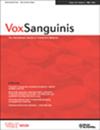Epitope Specificity and Inactivation Mechanisms of Factor VIII Inhibitor Antibodies
IF 1.8
4区 医学
Q3 HEMATOLOGY
引用次数: 0
Abstract
The domain specificity of anti‐factor VIII (FVIII) inhibitor antibodies was determined in assays using FVIII domains generated by thrombin cleavage or expressed as recombinant polypeptides to neutralise the inhibitor. The results revealed the existence of three major types of inhibitors, and various combinations of these antibodies were found in haemophilic and autoantibody patients. Anti‐A2 domain inhibitors prevent normal function of the FVIII/factor IXa (FIXa)/phospholipid complex in an unknown manner. Binding of FVIII to phospholipid and to von Willebrand factor is blocked by anti‐C2 domain antibodies, and the binding of FVIII to FIXa is prevented by anti‐A3 domain antibodies. A rare type of inhibitor prevents release of activated FVIII from von Willebrand factor (vWf), and another probably interferes with FVIII binding to factor X (FX) because it shares the epitope of a monoclonal antibody with this property.因子 VIII 抑制剂抗体的表位特异性和失活机制
在使用凝血酶裂解产生的或表达为重组多肽的 FVIII 结构域来中和抑制剂的试验中,确定了抗因子 VIII(FVIII)抑制剂抗体的结构域特异性。结果显示存在三种主要类型的抑制剂,在血友病患者和自身抗体患者中发现了这些抗体的各种组合。抗A2结构域抑制剂以一种未知的方式阻止FVIII/因子IXa(FIXa)/磷脂复合物的正常功能。抗C2结构域抗体会阻止FVIII与磷脂和von Willebrand因子结合,抗A3结构域抗体会阻止FVIII与FIXa结合。一种罕见的抑制剂可阻止活化的 FVIII 从 von Willebrand 因子(vWf)中释放,另一种抑制剂可能会干扰 FVIII 与 X 因子(FX)的结合,因为它与具有这种特性的单克隆抗体的表位相同。
本文章由计算机程序翻译,如有差异,请以英文原文为准。
求助全文
约1分钟内获得全文
求助全文
来源期刊

Vox Sanguinis
医学-血液学
CiteScore
4.40
自引率
11.10%
发文量
156
审稿时长
6-12 weeks
期刊介绍:
Vox Sanguinis reports on important, novel developments in transfusion medicine. Original papers, reviews and international fora are published on all aspects of blood transfusion and tissue transplantation, comprising five main sections:
1) Transfusion - Transmitted Disease and its Prevention:
Identification and epidemiology of infectious agents transmissible by blood;
Bacterial contamination of blood components;
Donor recruitment and selection methods;
Pathogen inactivation.
2) Blood Component Collection and Production:
Blood collection methods and devices (including apheresis);
Plasma fractionation techniques and plasma derivatives;
Preparation of labile blood components;
Inventory management;
Hematopoietic progenitor cell collection and storage;
Collection and storage of tissues;
Quality management and good manufacturing practice;
Automation and information technology.
3) Transfusion Medicine and New Therapies:
Transfusion thresholds and audits;
Haemovigilance;
Clinical trials regarding appropriate haemotherapy;
Non-infectious adverse affects of transfusion;
Therapeutic apheresis;
Support of transplant patients;
Gene therapy and immunotherapy.
4) Immunohaematology and Immunogenetics:
Autoimmunity in haematology;
Alloimmunity of blood;
Pre-transfusion testing;
Immunodiagnostics;
Immunobiology;
Complement in immunohaematology;
Blood typing reagents;
Genetic markers of blood cells and serum proteins: polymorphisms and function;
Genetic markers and disease;
Parentage testing and forensic immunohaematology.
5) Cellular Therapy:
Cell-based therapies;
Stem cell sources;
Stem cell processing and storage;
Stem cell products;
Stem cell plasticity;
Regenerative medicine with cells;
Cellular immunotherapy;
Molecular therapy;
Gene therapy.
 求助内容:
求助内容: 应助结果提醒方式:
应助结果提醒方式:


